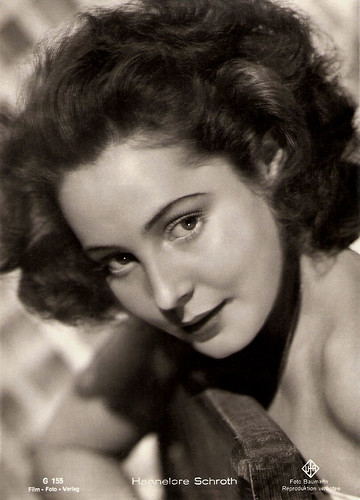
German postcard by Film-Foto-Verlag, no. G 155, 1941-1944. Photo: Baumann / Ufa.
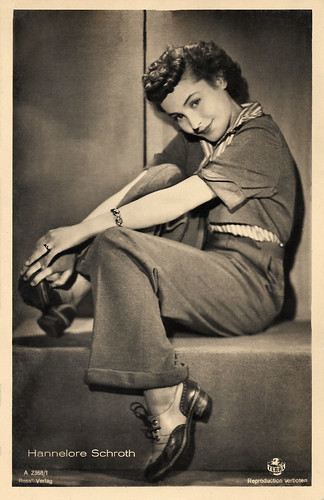
German postcard by Ross Verlag, no. A 2368/1, 1939-1940. Photo: Terra.

German postcard by Ross Verlag, no. A 2368/2, 1939-1940. Photo: Terra.
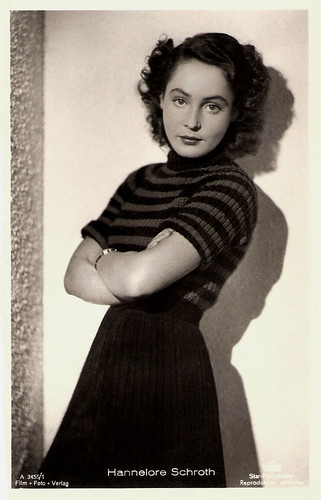
German postcard by Film-Foto-Verlag, no. A 3455/1, 1941-1944. Photo: Star-Foto-Atelier / Tobis.

German postcard by Film-Foto-Verlag, no. G 104, 1941-1944. Photo: Star-Foto-Atelier / Tobis.
Wonderfully natural
Hanne Lore Emilie Käte Grete Schroth was born in Berlin in 1922 as the daughter of actor Heinrich Schroth and actress Käthe Haack. Her half-brother Carl-Heinz Schroth would also become a well-known actor.
Hannelore already made her film debut at the age of nine in the short comedy Dann schon lieber Lebertran/I'd Rather Have Cod Liver Oil (Max Ophüls, 1931) opposite her mother, Käthe Haack. At sixteen, she attended a drama school in Lausanne.
To her early successes belong the love story Spiel im Sommerwind/Play in the Summer Breezes (Roger von Norman, 1938) with Rolf Möbius, and Kitty und die Weltkonferenz/Kitty and the World Conference (Helmut Käutner, 1939).
During the wartime, she continued her career with leading parts in Friedrich Schiller (Herbert Maisch, 1940) about the 18th-century German playwright and blank-verse poet, the romantic comedy Sophienlund (Heinz Rühmann, 1944) and Unter den Brücken/Under the Bridge (Helmut Käutner, 1945), a classic love triangle with Carl Raddatz and Gustav Knuth.
IMDb reviewer Christian Wasser calls the latter "one of the most beautiful love stories of the German cinema. The acting of Hannelore Schroth is wonderfully natural even today".
Unter den Brücken was one of the last films to be made in Nazi Germany - it passed the censorship in March 1945, but didn't make it to the cinemas as the street battles were about to commence in Berlin in a few weeks. In 1950, the film was finally shown in cinemas.

German postcard by Ross Verlag, no. A 2750/1, 1939-1940. Photo: Terra.

German postcard by Film-Foto-Verlag, no. A 3776/1, 1941-1944. Photo: Foto Haenchen / Bavaria Filmkunst.

German postcard by Ross Verlag, no. A 3233/1, 1941-1944. Photo: Baumann / Terra.
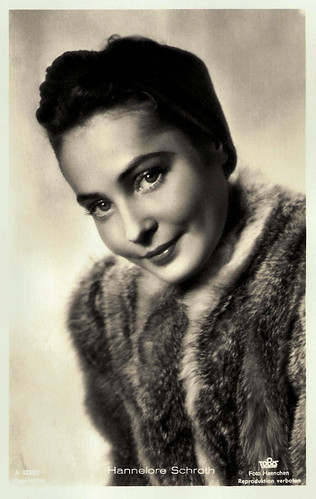
German postcard by Ross Verlag, no. A 3233/2, 1941-1944. Photo: Haenchen / Tobis.

German postcard by Ross Verlag, no. A 3359/1, 1941-1944. Photo: Haenchen / Tobis.
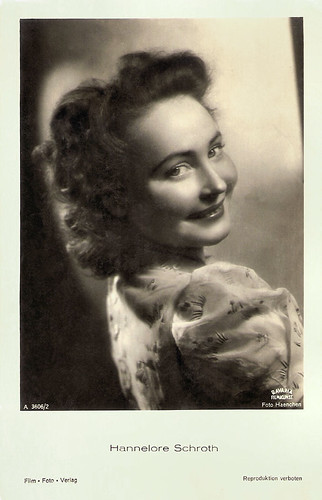
German postcard by Film-Foto-Verlag, no. A 3606/2, 1941-1944. Photo: Haenchen / Bavaria Filmkunst.
Emiiiil
After the war, Hannelore Schroth gained a foothold at the theater and also continued her film career with such hits as Taxi-Kitty (Kurt Hoffmann, 1950) and Kommen Sie am Ersten/Come at the First (Erich Engel, 1951).
Later well-known films are the classic comedy Der Hauptmann von Köpenick/The Captain from Köpenick (Helmut Käutner, 1956), the romantic drama Wie einst Lili Marleen/Like Once Lili Marleen (Paul Verhoeven, 1956) with the wartime song hit Lili Marlene woven into its plotline, and the comedy Der Mann, der nicht nein sagen konnte/The Man Who Could Not say No (Kurt Früh, 1958) with Heinz Rühmann.
She also became a popular voice actor and dubbed such Hollywood stars as Shirley MacLaine and Elizabeth Taylor.
From the 1950s on, regular engagements for TV followed. She became well-known for a younger audience when she impersonated the role of Mrs. Petrell in the successful Swedish film- and TV series Emil (Olle Hellbom, 1971-1976). The three feature films and the TV series were based on the novels by Astrid Lindgren about the 5-year-old prankster Emil, who lives with his family on a farm in the district of Lönneberga in Sweden, at the start of the 20th century.
To Hannelore Schroth's last films belong the comedy Bomber & Paganini (Nicos Perakis, 1976) starring Mario Adorf, and Zwischengleis/Yesterday's Tomorrow (Wolfgang Staudte, 1978) with Pola Kinski. In 1980, Schroth was awarded the Filmband in Gold for her achievements in German cinema.
Hannelore Schroth died in 1987 in München (Munich). She had been married to the actor Carl Raddatz, her co-star of Unter den Brücken, and from 1945 till 1950 with the Austrian deep-sea diver Hans Hass. Her son from that marriage, Hans Hass Jr., was an actor and singer. From her third marriage with a lawyer and film producer also comes a son, Christopher Köster.

German postcard by Film-Foto-Verlag, no. A 3845/1, 1941-1944. Photo: Baumann / Ufa.

German postcard by Ross Verlag, no. A 2857/1, 1939-1940. Photo: Haenchen / Tobis.
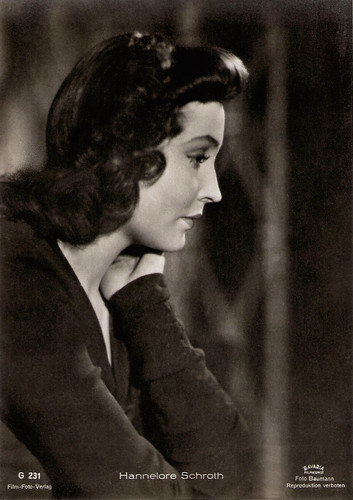
German postcard by Film-Foto-Verlag, no. G 231, 1941-1944. Photo: Baumann / Bavaria.
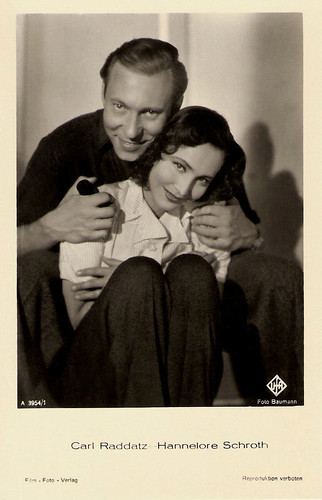
With Carl Raddatz. German postcard by Film-Foto-Verlag, no. A 3954/1, 1941-1944. Photo: Baumann / Ufa.
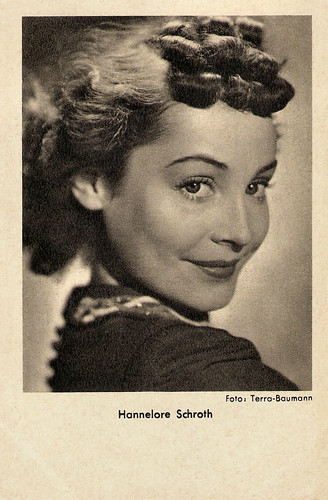
German postcard. Photo: Baumann / Terra.
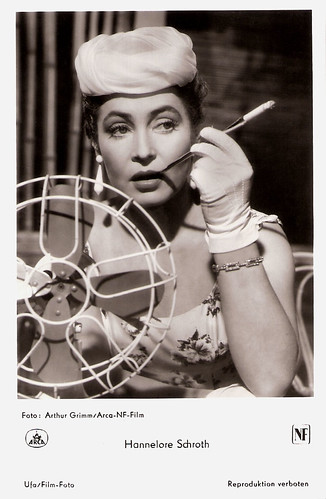
German postcard by Ufa, Berlin-Tempelhof, no. FK 3492. Retail price: 25 Pfg. Photo: Arthur Grimm / Arca-NF-Film.
Sources: Thomas Staedeli (Cyranos), Filmportal.de, Wikipedia (German), and IMDb.
No comments:
Post a Comment